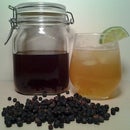Introduction: Espresso Roe Dessert Sushi
Sushi is delicious.
Dessert is delicious.
These facts are self evident.
But what if we could combine the two?! Mind. Blown.
One of my favorite sushi rolls is the ikura (salmon roe) roll. Brightly colored salmon eggs that pop in your mouth and taste like the ocean breeze. If only I could get the same sweet rather than savory effect for dessert...maybe get a caffeine kick while I'm at it? Oh, and chocolate. Let's put some chocolate in there.
Let's make it happen.
Milk chocolate shell "nori," panna cotta "rice," and espresso "roe" using the power of molecular gastronomy. This is a dessert of desserts, so make sure to show these off when you make them.
Step 1: On a Roll
To make these, you will need:
Sodium Alginate
Calcium Lactate
Espresso (this can be instant espresso powder + water)
Chocolate chips (ignore the fancy block of chocolate in the picture--I'll explain later)
[Heavy cream
Sugar
Vanilla
Gelatin powder] - for panna cotta
or
Whipped cream (from a can or homemade)
And also:
A cylinder (paper towel roll or similar)
Wax paper
Tape
Scissors
A scale (ideally)
Some kind of dropper (pipette, syringe, straw, etc.)
Lots of bowls and silverware
A fancy plate (for displaying)
Step 2: Rice Rice Baby
If you decide to use panna cotta, you'll want to start about four hours in advance so that it'll have time to set. Here's how to make enough for 8-ish pieces of sushi, depending on how big they are.
INGREDIENTS:
1 1/2 cups heavy cream
1 package gelatin
1/4 cup sugar
1/2 teaspoon vanilla extract
DIRECTIONS:
- Put about half the cream in a saucepan and sprinkle the gelatin over it
- Let it sit for about 5 minutes, and then turn the heat to low and stir gently until the gelatin dissolves
- Add the rest of the cream, the sugar, and the vanilla
- Turn heat to medium and stir until it starts steaming
- Put a cover on it and let it sit for ~15 minutes
- Let cool, then put in the refrigerator and let it sit until it sets (3 or 4 hours)
Step 3: Chocolate Reign?
- The first thing you want to do is to prep your cylinder with markings to show how tall the rolls should be. This will make it easier to make them all the same height. Take some tape and mark off a sushi-looking length on your cylinder.
- Tear off a piece of wax paper big enough to wrap around your cylinder, and cut it in half.
- Wrap one of the halves around the cylinder, and tape down the seam.
- Wrap two pieces of tape around the cylinder, lining them up above and below the guide on the cylinder. Fold the tape under at the ends so you'll be able to pull it off easily.
Step 4: Chocolate Reign, Part II
- Put the chocolate chips in a microwave-safe bowl.
- Microwave at 20-second intervals until the chocolate chips are just starting to get shiny--they should still be shaped like chocolate chips.
- Stir like crazy. You should have chocolate that is spreadable but not liquid.
- Using a butter knife, spread the chocolate between the two strips of tape around the circumference of your cylinder, going lengthwise.
- Get a little more chocolate on your knife and go around the cylinder with the flat of the blade, smoothing it out. Make sure not to let the chocolate get too thin.
- Let it air-dry for a few seconds, then pull off the two horizontal strips of tape, leaving a perfect cylinder of chocolate
- Carefully pull the wax paper cylinder away from the cylinder form and stand it up in your freezer for a few minutes. The refrigerator should also work, if you leave it there longer.
- Repeat until you have as many chocolate cylinders as you want to make.
- Gently push the wax paper away from the chocolate, pushing on either side of the chocolate cylinder at once. This is important, and why you can't just use the edge of the wax paper in place of one of the pieces of tape. When the paper is almost completely detached, twist it to fully disengage the paper.
- If you didn't spread your chocolate too thin, you should now have a chocolate cylinder, ready to be filled. Put it on a plate and admire it.
Step 5: She Blinded Me With (Food) Science!
So you've gotten the easy part out of the way. Any fool can make custard and make chocolate into a cylinder, right? Now it's time for what this dessert is really all about: Molecular Gastronomy.
Let's let the phrase marinate a bit and get over some common misconceptions. Molecular Gastronomy approaches food and the art of cooking with a rigorous, scientific zeal. We know egg whites solidify at a certain temperature, but what is going on within the egg white itself? Does altitude, freshness, chicken diet, or water salinity have anything to do with it? These types of questions, seeking to isolate and pinpoint the how and why of food, are what spurred techniques in molecular gastronomy. If you'd like to learn more about the history of molecular gastronomy, as well as details about the science behind the how and why of your food, don't hesitate to check out On Food and Cooking by Harold McGee.
Molecular gastronomy may be best known for its use in in stuffy and expensive small plate establishments (I may be bitter over the cost and wait for Alinea...), but the techniques used have been a part of our culinary language for years. Check the stabilizers and additives in any food you buy (the pimento pieces found in green olives are produced exactly the same way as this espresso roe!). If anyone raises a "chemicals in our food" line with you, gently remind them the food you are eating is a vast array of chemical and biological reactions cooperating and competing against each other. These ingredients have passed rigorous and lengthy health standards with flying colors, and make an amazing addition to your culinary tool-belt.
Molecular Gastronomy has a relatively low cost of entry, as well.
Sodium Alginate-
http://www.thespicehouse.com/spices/Algin#content
(Carbohydrate derived from brown algae that forms a gel upon contact with calcium ions)
Calcium Lactate-
http://www.thespicehouse.com/spices/calcium-salt
(Calcium ion source that dissolves in water- may taste bitter, but harmless)
The two ingredients used in this recipe go for less than $7.50 (+ tax and/or shipping) and are used in small quantities (on the order of grams). Inexpensive, and long lasting. If you don't have a food scale that is accurate to the gram, you may want to invest in one later- after all, food is science. But this technique is pretty resilient to estimation if you know what to look for.
Step 6: Xanthine Alkaloids and You! (Espresso Time)
I used a powdered espresso for this recipe, and prepared it a bit stronger than what the instructions dictate. Remember that these espresso caviar spheres will be small- you'll want them to pack a punch of flavor that you'll notice in just a few caviar "drops". In my case, the espresso was a bit bitter, so I added 3 tsp of sugar. You can substitute fresh espresso, or even strongly flavored fruit juices- just be careful with the acidity, as anything too acidic will throw off the reaction.
- three teaspoons espresso
- three teaspoons sugar
- 9 oz water
__________
158 g of espresso liquid
-
Add enough Sodium Alginate to make your espresso a 1% sodium alginate solution. Divide the grams of liquid you have by 100 to figure out how much Sodium Alginate you need to use. In my case, it was about 1.58 g. You'll be able to modify the solution after the fact if things aren't working out right or your drops aren't forming properly.
-
Mix thoroughly. I used a latte foamer, but you can use anything you like- a hand mixer or a whisk will do just fine. The solution will be quite foamy- don't worry.
-
Pass through a fine mesh strainer a few times, or let sit in the fridge until the foam has dissipated. Discard any lumps that may have formed- this may be due to hard water, or cross contamination. Sodium Alginate is sensitive to calcium.
- Set aside and go on to prepare the calcium bath.
Step 7: Calci-yum?
You'll need a 1% calcium solution to serve as a bath for your spheres. As you drip the espresso into this bath, the outside of the droplet will form a carbohydrate shell, forming your caviar. The longer you let your caviar sit, the firmer the shell will be until your drop eventually solidifies.
Time for some simple chemistry mathemagic for those of you without a kitchen scale. You may want to consult the internet/ wikipedia for densities if you have a different ingredient.
3 cups water---> 709ml water
Density of water ~ 1g/ml
709ml x 1g/ml = 709g
709 g of water means you'll need 7.09 g of Calcium Lactate (1% solution)
Density of Calcium Lactate ~1.5 g/ml
7.09 g / 1.5 g/ml = 4.7ml
You need about 4.7 ml of Calcium Lactate, or about 1 teaspoon. Easy. Mix this into your three cups of water until it dissolves.
Time to Spherify.
Step 8: Sphere Is the Mind-Killer?
For my caviar, I used what I lovingly refer to as a sawed-off pipette. Experiment with what you have available, and see what kind of sizes and shapes you can produce. Syringes (without needles, check your drugstore) of different sizes are commonly used, as well as pipettes and other types of droppers. You can even use teaspoons to produce a ravioli effect.
Take your drop-making implement of choice and drip the espresso / Sodium Alginate mixture into the calcium bath, one drop at a time. Release the drops as close to the bath as possible so that they don't solidify in funny shapes due to the impact.
When you're out of espresso-mixture or have as much caviar as you want, pour the contents of the bath through a strainer over the sink. Make sure to gently rinse your caviar to wash off the bitter calcium water solution.
Note: if your caviar doesn't form and just dissolves, you may need to have a stronger Calcium bath. Experiment with the bath first in small quantities, followed by your Alginate solution. If the drops form too quickly, your bath may be too strong. Try adding more water and trying again. They may be fragile, depending on how long you've let them soak, so be careful.
Due to this particular method, the caviar will continue to solidify slowly after formation- eat them quickly if you want that pop or prepare them last. There is also another method called reverse spherification, in which your liquid contains calcium and is dripped into an Alginate bath (opposite of what we've done here). This method has a thicker, but non-progressing shell for your liquid. Stay tuned in the comments for my experiment with that.
Time for assembly.
Step 9: Sushi Time
- Spoon your panna cotta into the chocolate cylinder (or if you went the lazy route, squirt some whipped cream in there) until the cylinder is almost full.
- Carefully spoon the espresso roe on top of your filling until the cylinder is covered.
- If you want some plate decor, you can use your cardboard cylinder form to punch little discs of panna cotta, and then scatter some extra roe around. Or drizzle some chocolate around. Make it look nice.
- Take artsy photographs of your masterpiece. You've earned it.
Serve this as the dessert for a sushi dinner party, and all your friends will forever think you're 100% classier than you are in real life. Guaranteed.

First Prize in the
Coffee Challenge












